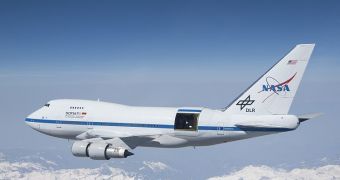Officials at the American space agency say that the NASA’s Stratospheric Observatory for Infrared Astronomy (SOFIA) has begun its first international mission, conducted outside the United States.
The effort began at 10:10 am PST (1713 GMT) on Friday, September 16, when the airborne telescope took off from Palmdale, California. It flew east, over the continental United States, and then over the Atlantic Ocean, all the way to Cologne, Germany.
This is to be the first international deployment of the extremely complex Boeing aircraft, which NASA modified to carry a large infrared telescope embedded in its fuselage. SOFIA landed at the Cologne-Bonn Airport at 7 am local time.
On Sunday, September 18, the aircraft was featured at the German Aerospace Day, an event organized at the airport, which showcased a number of aircraft. This is the annual open house of the German Aerospace Center (DLR), one of two major contributors to the flying telescope project.
On Tuesday, September 20, the aircraft flew to Stuttgart, where it participated in an exhibition on IR astronomy. The event was organized by the University of Stuttgart's German SOFIA Institute (DSI).
Today, September 22, the observatory will take off from Germany, and carry out a 10-hour scientific flight, as it flies west, over the Atlantic Ocean, and into the United States. The project is the result of a collaboration between NASA, DLR, DSI and the Universities Space Research Association (USRA).
SOFIA is currently based at the NASA Dryden Aircraft Operations Facility, which is located on grounds at the Plant 42 military installation. The Edwards Air Force Base (EAFB) is located nearby.
“It is a privilege to fly SOFIA to Germany to showcase the work of our international partner. The DLR and the DSI have collaborated with NASA and its partners in developing this world-class observatory,” explains NASA SOFIA program manager Bob Meyer.
“SOFIA’s appearance here is a matter of national pride, both for the United States and Germany,” the official goes on to say. He explains that the aircraft conducts its science operations from an altitude of about 39,000 to 45,000 feet (11,887 to 13,716 meters)
This altitude ensures that the modified Boeing 747SP wide-body aircraft flies above 99 percent of all water vapors in Earth's atmosphere. In turn, this helps its IR instruments conduct complex observations of distant cosmic objects.

 14 DAY TRIAL //
14 DAY TRIAL //